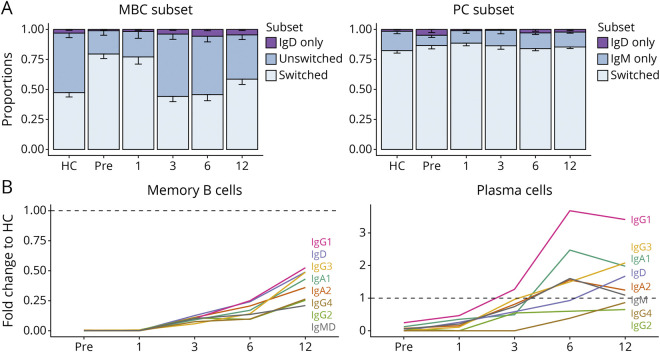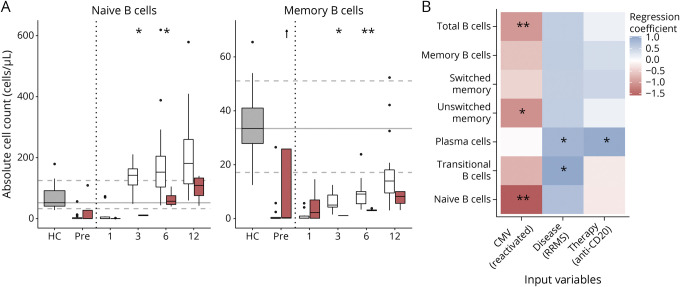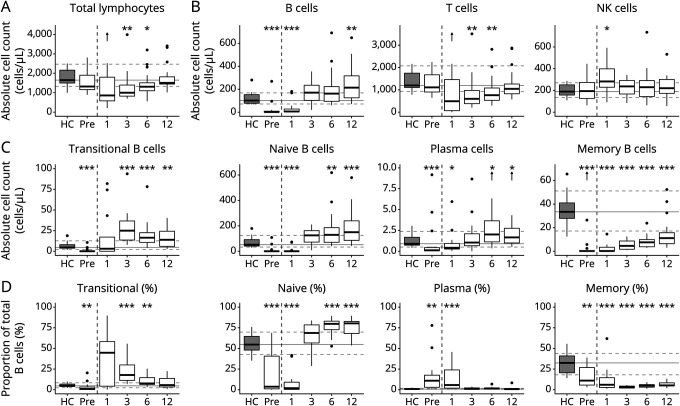B-Cell Reconstitution After Autologous Hematopoietic Stem Cell Transplantation in Multiple Sclerosis.
Neurology(R) neuroimmunology & neuroinflammation
Pub Date : 2022-10-13
Print Date: 2022-11-01
DOI:10.1212/NXI.0000000000200027
引用次数: 5
Abstract
Background and Objectives Autologous hematopoietic stem cell transplantation (aHSCT) is increasingly used to treat aggressive forms of multiple sclerosis (MS). This procedure is believed to result in an immune reset and restoration of a self-tolerant immune system. Immune reconstitution has been extensively studied for T cells, but only to a limited extent for B cells. As increasing evidence suggests an important role of B cells in MS pathogenesis, we sought here to better understand reconstitution and the extent of renewal of the B-cell system after aHSCT in MS. Methods Using longitudinal multidimensional flow cytometry and immunoglobulin heavy chain (IgH) repertoire sequencing following aHSCT with BCNU + Etoposide + Ara-C + Melphalan anti-thymocyte globulin, we analyzed the B-cell compartment in a cohort of 20 patients with MS in defined intervals before and up to 1 year after aHSCT and compared these findings with data from healthy controls. Results Total B-cell numbers recovered within 3 months and increased above normal levels 1 year after transplantation, successively shifting from a predominantly transitional to a naive immune phenotype. Memory subpopulations recovered slowly and remained below normal levels with reduced repertoire diversity 1 year after transplantation. Isotype subclass analysis revealed a proportional shift toward IgG1-expressing cells and a reduction in IgG2 cells. Mutation analysis of IgH sequences showed that highly mutated memory B cells and plasma cells may transiently survive conditioning while the analysis of sequence cluster overlap, variable (IGHV) and joining (IGHJ) gene usage and repertoire diversity suggested a renewal of the late posttransplant repertoire. In patients with early cytomegalovirus reactivation, reconstitution of naive and memory B cells was delayed. Discussion Our detailed characterization of B-cell reconstitution after aHSCT in MS indicates a reduced reactivation potential of memory B cells up to 1 year after transplantation, which may leave patients susceptible to infection, but may also be an important aspect of its mechanism of action.



自体造血干细胞移植治疗多发性硬化症后b细胞重建。
背景和目的:自体造血干细胞移植(aHSCT)越来越多地用于治疗侵袭性多发性硬化症(MS)。这一过程被认为会导致免疫重置和自我耐受免疫系统的恢复。免疫重建对T细胞的研究非常广泛,但对B细胞的研究却非常有限。随着越来越多的证据表明B细胞在MS发病机制中的重要作用,我们在此寻求更好地了解MS患者aHSCT后B细胞系统的重建和更新程度。我们使用纵向多维流式细胞术和免疫球蛋白重链(IgH)库测序,在使用BCNU + Etoposide + Ara-C + Melphalan抗胸腺细胞球蛋白进行aHSCT后,分析了20名MS患者在aHSCT前和aHSCT后1年的特定时间间隔内的b细胞区室,并将这些结果与健康对照组的数据进行了比较。结果:b细胞总数在移植后3个月内恢复,并在移植后1年高于正常水平,先后从主要过渡到初始免疫表型。移植后1年记忆亚群恢复缓慢,保持在正常水平以下,记忆库多样性降低。同型亚类分析显示,向表达igg1的细胞成比例转移,而IgG2细胞减少。对IgH序列的突变分析表明,高度突变的记忆性B细胞和浆细胞可能短暂存活,而对序列簇重叠、可变(IGHV)和连接(IGHJ)基因使用和库多样性的分析表明移植后晚期库的更新。在早期巨细胞病毒再激活的患者中,初始B细胞和记忆B细胞的重建被延迟。讨论:我们对MS患者aHSCT后B细胞重建的详细描述表明,移植后1年内记忆B细胞的再激活电位降低,这可能使患者易受感染,但也可能是其作用机制的一个重要方面。
本文章由计算机程序翻译,如有差异,请以英文原文为准。
求助全文
约1分钟内获得全文
求助全文

 求助内容:
求助内容: 应助结果提醒方式:
应助结果提醒方式:


